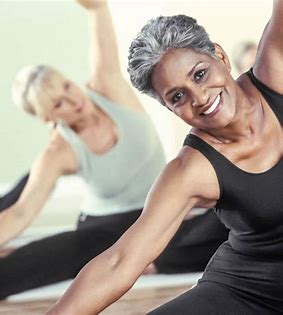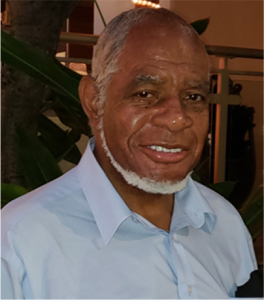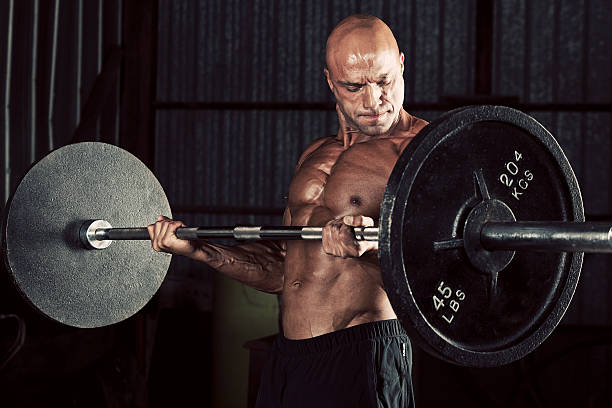One of our blog readers recently stated that they were a senior up in age and could not get back in shape. They claimed they were usually exhausted and had poor knees. After reading these comments, I decided to blog about this situation and offer some encouragement, inspiration, and strategies for addressing problems to these complex issues. We go back in time; when we were young, we were active, always pulling, jumping, running, and engaged in physical activity. Unfortunately, as we get older, our eating habits deteriorate, doing minimal exercise, find shortcuts to accomplish a thing, and become exceptionally inactive.
Over half of the elderly population are idle because of torment and uneasiness. It incorporates back pain, heart condition, sore knees, and lung disorders that can be barriers to exercise that will affect willpower and motivation. Additionally, adiposity, obesity, and being overweight can significantly influence healthy activity in older adults. The article will address why you should exercise. Suggestion on good dieting. Getting the proper amount of sleep. Exercise plans for different problem concerns
As we age, one of the biggest fears is becoming frail and dependent on others for our basic needs. While this may be a reality for some, it does not have to be for everyone. As we get older, we can do many things to maintain our health and independence proactively. Getting back in shape is one of these things, and it’s not as hard as you might think! This post will explore tips for getting back into shape at any age.
Let’s get started!
Aging Changes over Two Centuries
The elderly lived with their family units Historians and researchers did very few studies because they were not of interest and rarely discussed; they were not in vogue as a division of the family unit and division of responsibility. People started moving away from the farm to the significant city life, which was more sedentary.
The elderly population has changed drastically over two centuries. In 1750, there were hardly any studies on why elderly adults maintained good conditioning in their senior years. However, by 1900, the family unit began to split up and move away to the larger industrial cities.-the situation had shifted dramatically

The elderly population has been on the rise for centuries, but it wasn’t until recently that researchers took notice. The reasons behind this sudden increase in age-related changes are mainly due to society’s changing attitudes about families and responsibilities and people moving away from farming communities, leading them into large cities where more sedentary lifestyles become prevalent.
Reviewing Our Past Physical Activity
Every day while attending grade school, your teacher ensured you spent time in the schoolyard exercising, including kickball, softball, basketball, flag football, tedder ball, jump rope, and hopscotch. When you attended junior high school (middle school), your activities included baseball, basketball, track and cross country, football¸hand ball, dancing, and gym class. In high school, you were active with gym class, dance classes, handball, basketball, track& field, football, cross country, tennis, and bat mitten. Yet, when you graduate from high school, over 65% of attendees discontinued activities that would keep their activity. Why?
Because of the newfound responsibility of going to college, becoming a full-time student, or working full-time on a 40-hour job per week keep you very busy and tired. Studies show less than 25 percent of the population stayed very active during this time. Many adults don’t understand that the lack of exercise and a sedentary lifestyle can harm their health.
Tools to Fight with
The number one tool use to fight a sedentary lifestyle is self-motivation. You must motivate yourself to realize that “you can, you will, you must” and get your body back in excellent condition. Believe that exercising is positively affecting you.
Seek help from someone who shares your passion by wanting to get in excellent condition and stay in good shape. Develop a buddy system;
Consult your physician before starting any dietary and exercise program. Then, shop around and find someone you can trust to help you with your meals and a good exercise plan.
Restore your Balance

The primary cause of the elderly losing balance is the natural aging process, which often decreases muscle strength, coordination, and flexibility. Other causes include medical conditions such as arthritis, neurological disorders, or medications. Exercises that can help the elderly regain their balance focus on improving strength to solve this problem. What strength exercise for the legs to support the balance of the elderly?
Strength exercises for the legs are an effective way of helping improve balance in the elderly. Such exercises include squats, lunges, calf raises, and leg presses. These are all designed to increase muscular strength, which helps with balancing. Stretching exercises can also be beneficial as they help to maintain flexibility and range of motion around the joints. For example, stretching the hamstrings, quadriceps, and hip flexors can all help make standing up or regaining balance easier.
Additionally, exercises such as tai chi and yoga can be very beneficial in helping improve balance. These activities incorporate deep stretching and controlled movements that help build strength, coordination, and stability. These activities can be done within the home and require no additional equipment. Staying active also helps to improve overall health, mental functioning, weight control, and mobility. For elderly adults, getting in shape for life may not be as easy as it once was, but staying healthy and balanced is possible with some commitment and dedication. Appropriate exercise regimens and making healthy choices regarding diet can help you stay active and improve your quality of life. Staying physically active is essential to living a healthy lifestyle and can help you continue enjoying life for many years. So regardless of age, start moving today and make getting in shape for life your goal!
Exercising with Knee Complication
Elderly adults with knee complications may find it difficult to exercise the same way as those without physical constraints. However, there are still various ways to get fit and stay active. A few exercises that can help an elderly adult with bad knees get in shape include:
- Stretching: Stretching can help to improve flexibility and range of motion, allowing for an easier time exercising. Stretches should focus on the calf muscles, hamstring, quadriceps, and gluteus muscles to reduce knee pain.
- Swimming: Many elderly adults find swimming a gentler way to exercise than running or other high-impact activities. Swimming can even help to reduce pain and improve mobility in the legs and joints, as the water provides a cushion for the body.
- Cycling: Although it can be difficult after a certain age, cycling is an excellent way to keep muscles active while being gentle on the knees. Stationary bikes are great for those who aren’t comfortable riding outside and can provide a great cardio workout.

No matter what exercise you decide to do, it is essential to remember that consistency is vital. Staying active every day or even every other day can help keep your muscles from getting too stiff and make it easier to stay in shape “for life.”
Exercising to Rid Obesity
Exercising is essential to getting in shape, especially for elderly adults. Staying active and exercising can help reduce the risk of obesity, which, unfortunately, has become more common among the elderly population. Here are a few ways that elderly adults can begin to exercise and get in shape:
- Walking is one of the most effective forms of exercise for elderly adults, requiring minimal effort anywhere.
- Stretching: Stretching is significant for elderly adults, as it helps to improve flexibility and balance, reduce joint pain, and improve posture.
- Swimming: Swimming is an excellent form of exercise for the elderly, as it helps to build strength and cardiovascular endurance.
- Yoga is a great way to improve flexibility, balance, and coordination while reducing stress levels.
Exercising can help to reduce the risk of chronic diseases in elderly adults and improve overall physical health. With a few changes to your daily routine, you can get yourself in shape for life. Staying active and exercising can help keep your body and mind healthy into old age. So don’t be shy – start getting in shape today and make sure you are living your best life!
No matter what type of exercise you choose, starting slowly and not overdoing it is essential. Listen to your body and take regular breaks to ensure you are not over-exerting yourself. It is also important to consult a doctor before starting any new exercise routine, especially if you have any existing medical conditions.
You are getting in shape while elderly can be a challenging but rewarding experience. Staying active and exercising can help you stay healthy, improve your balance, and boost your mood. With the right attitude and dedication, you can make physical activity part of your life today! Staying active is vital to stay healthy, so don’t wait any longer – get up and start moving!
Your doctor will help you devise a fitness plan tailored to your needs. They can guide how to safely and effectively exercise at any age. Be sure to take it slow and ensure you are not over-exerting yourself. Staying active can help keep your heart and bones strong, improve balance and coordination, aid in weight management, reduce stress levels, and even lift your mood.
Start with simple exercises such as walking or jogging for a few minutes a day, and gradually increase the intensity of your routine as you go along. Stretching can also be beneficial as it helps maintain flexibility in your joints. Joining a class or personal training session may also be helpful if you want to make exercising more enjoyable and social.
Remember that physical activity doesn’t have to be boring! Find activities you enjoy, such as swimming, biking, gardening, hiking, dancing, or tennis. Staying active will help you maintain and improve your overall health. So get out there, move around and have some fun!
Finally, consult a healthcare professional before starting any exercise routine to ensure it’s safe for you.
Conclusion
Staying physically active is vital at any age, but especially for elderly adults. Daily exercise can help reduce risks of chronic health conditions, improve mental and emotional being, and even maintain independence. Whether it’s walking, swimming, biking, or some other type of physical activity, exercising will help you stay in shape for life. So get out there and have some fun! Staying active will help you continue enjoying the world around you for many years.
By being physically active, elderly adults are giving themselves a chance to stay in shape while improving their overall health, safety, and quality of life. Staying active and exercising will help build muscle strength, endurance, balance, and flexibility. In addition, exercise can reduce the risk of falls, improve coordination and posture, and help keep your bones strong and healthy.
Studies have also shown that physical activity can reduce stress and anxiety, strengthen the heart muscles, lower blood pressure, and improve cardiovascular and respiratory functions. In addition, exercising reduces feelings of depression, boosts your mood, helps control weight gain, increases energy levels and alertness, and improves the overall quality of life.
Finding an activity, you enjoy while staying safe at the same time is essential. Stretching exercises are a great way to warm up before any strenuous activity. In addition, stretching will help to reduce the risk of pulled or strained muscles. Before starting any exercise program, check with your doctor to ensure it is safe for you.
Other activities in the comfort of your home include walking, jogging, swimming, and yoga. Walking is an excellent activity for people of all ages and fitness levels. Finding a comfortable walking pace that works best for you is vital. Jogging is also a fantastic activity, but it’s essential to be aware of any health conditions that may affect your ability to do so safely. Swimming is always a fun and healthy way to exercise and offers minimal injury risk. Yoga is a great way to increase strength and flexibility while clearing your mind and body.
Staying active will help you stay healthy, fit, and energized. Exercise can also reduce stress levels, improve cognitive function, and make everyday activities easier. Staying active is essential to maintaining good health as an elderly adult. So find activities you enjoy, and incorporate them into your weekly routine!
It is never too late to start exercising. Staying active daily can help prevent or manage chronic illnesses such as diabetes, high blood pressure, arthritis, etc. You’ll also be able to increase your strength, flexibility, and balance.
Before you start an exercise program, it is best to get a check-up with your doctor. This will help determine the best type of activity for your body. Low-impact exercises such as walking and swimming are perfect for elderly adults who want to stay active without putting too much strain on their bodies.
Once you plan, think about how and when you want to exercise. You can use the activities you enjoyed while attending school as an inspiration. Activities like kickball and basketball are great options for increasing your heart rate. Yoga or tai chi classes can help improve flexibility and balance. Stretching is also essential and can help prevent injury.
Remember, exercising doesn’t have to be complicated. Staying active is the key to living a healthy life! So choose activities that you enjoy and stick with them. With effort and consistency, you will soon reap the benefits of improved physical well-being. Staying motivated can be challenging, so find a friend or family member to join you. Together, you can make exercise a fun part of life!
It’s never too late to get in shape; it just takes dedication, patience, and an understanding of the importance of physical activity and exercise. So set realistic goals, take things one step at a time, and you will soon reap the rewards. Staying active and exercising can help keep your body strong, reduce stress, and increase your overall happiness!
Good luck on your fitness journey! Staying active and exercising can be the key to enjoying life for years to come. So “Keep On Keepin’ On.”






